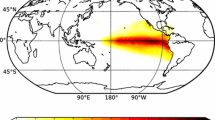Abstract
The climate during the Last Glacial Maximum (LGM) has been simulated using the UK Universities Global Atmospheric Modelling Programme (UGAMP) general circulation model (GCM) with both prescribed sea surface temperatures (SSTs) based on the CLIMAP reconstruction and computed SSTs with a simple thermodynamic slab ocean. Consistent with the Paleoclimate Modelling Intercomparison Project (PMIP), the other boundary conditions include the large changes in ice-sheet topography and geography, a lower sea level, a lower concentration of CO2 in the atmosphere, and a slightly different insolation pattern at the top of the atmosphere. The results are analysed in terms of changes in atmospheric circulation. Emphasis is given to the changes in surface temperatures, planetary waves, storm tracks and the associated changes in distribution of precipitation. The model responds in a similar manner to the changes in boundary conditions to previous studies in global mean statistics, but differs in its treatment of regional climates. Results also suggest that both the land ice sheets and sea ice introduce significant changes in planetary waves and transient eddy activity, which in turn affect regional climates. The computed SST simulations predict less sea ice and cooler tropical temperatures than those based on CLIMAP SSTs. It is unclear as to whether this is a model and/or a data problem, but the resulting changes in land temperatures and precipitation can be large. Snow mass budget analysis suggests that there is net ice loss along the southern edges of the Laurentide and Fennoscandian ice sheets and net ice gain over other parts of the two ice sheets. The net accumulation is mainly due to the decrease in ablation in the cold climate rather than to the changes in snowfall. The characteristics of the Greenland ice-sheet mass balance in the LGM simulations is also quite different from those in the present-day (PD) simulations. The ablation in the LGM simulations is negligible while it is a very important process in the ice mass budget in the PD simulations.
Similar content being viewed by others
Author information
Authors and Affiliations
Additional information
Received: 10 January 1997 / Accepted: 11 December 1997
Rights and permissions
About this article
Cite this article
Dong, B., Valdes, P. Simulations of the Last Glacial Maximum climates using a general circulation model: prescribed versus computed sea surface temperatures. Climate Dynamics 14, 571–591 (1998). https://doi.org/10.1007/s003820050242
Issue Date:
DOI: https://doi.org/10.1007/s003820050242




